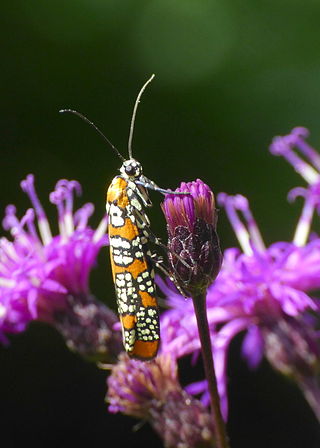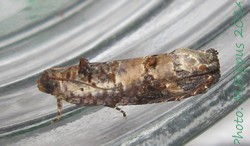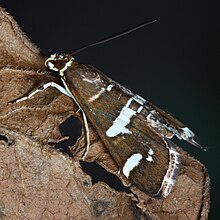
The ailanthus webworm is an ermine moth now found commonly in the United States. It was formerly known under the scientific name Atteva punctella. This small, very colorful moth resembles a true bug or beetle when not in flight, but in flight it resembles a wasp.

The Pyraloidea are a moth superfamily containing about 16,000 described species worldwide, and probably at least as many more remain to be described. They are generally fairly small moths, and as such, they have been traditionally associated with the paraphyletic Microlepidoptera.

The fall webworm is a moth in the family Erebidae known principally for its larval stage, which creates the characteristic webbed nests on the tree limbs of a wide variety of hardwoods in the late summer and fall. It is considered a pest but does not harm otherwise healthy trees. It is well known to commercial tree services and arboriculturists. Fall webworms are an invasive species in East Asia.

Galacticidae is a recently recognised and enigmatic family of insects in the lepidopteran order. These moderate sized moths are 8–17 mm in wingspan and have previously been embedded within several lepidopteran superfamilies, but Galacticidae is currently placed in its own superfamily at the base of the natural group Apoditrysia.

The genus Crambus includes around 155 species of moths in the family Crambidae, distributed globally. The adult stages are called crambid snout moths, while the larvae of Crambus and the related genus Herpetogramma are the sod webworms, which can damage grasses.

Spoladea is a genus of moths of the family Crambidae described by Achille Guenée in 1854.

Hellula undalis, the cabbage webworm or Old World webworm, is a moth of the family Crambidae. It is a widespread species which is found from Europe across Asia to the Pacific. It was first described from Italy.

Herpetogramma licarsisalis, commonly known as the grass webworm or pale sod-webworm, is a species of moth in the family Crambidae.

Dudua aprobola, the mango flower webworm or litchi leaf roller, is a moth of the family Tortricidae. The species was first described by Edward Meyrick in 1886. It is a pest on several economically important crops.

Parapediasia teterrellus, the bluegrass webworm moth, bluegrass webworm, bluegrass sod webworm moth or bluegrass sod webworm, is a moth of the family Crambidae.

Hellula rogatalis, the cabbage webworm, is a moth of the family Crambidae described by George Duryea Hulst in 1886. It is found from the southern United States north in the east to Maryland, New York and Ontario. It is also found in Mexico, where it has been recorded from Distrito Federal.

Hymenia perspectalis, the spotted beet webworm moth, is a species of moth of the family Crambidae. It is found in various parts of the world, including North America, where it is found from Maine to Florida, west to Texas and north to Michigan and Ontario. It is also found in Belize, Hong Kong, Jamaica, Australia (Queensland), the Comoros, Equatorial Guinea, Réunion and South Africa. The species was described by Jacob Hübner in 1796.

Herpetogramma bipunctalis, commonly known as the southern beet webworm moth or two-spotted herpetogramma, is a species of moth in the family Crambidae. It is found from New England to Florida, west to Texas and north to Illinois. In the south, the range extends through Central America and the Caribbean to South America.
Hymeniini is a tribe of the species-rich subfamily Spilomelinae in the pyraloid moth family Crambidae. The tribe was erected by Charles Swinhoe in 1900.
















